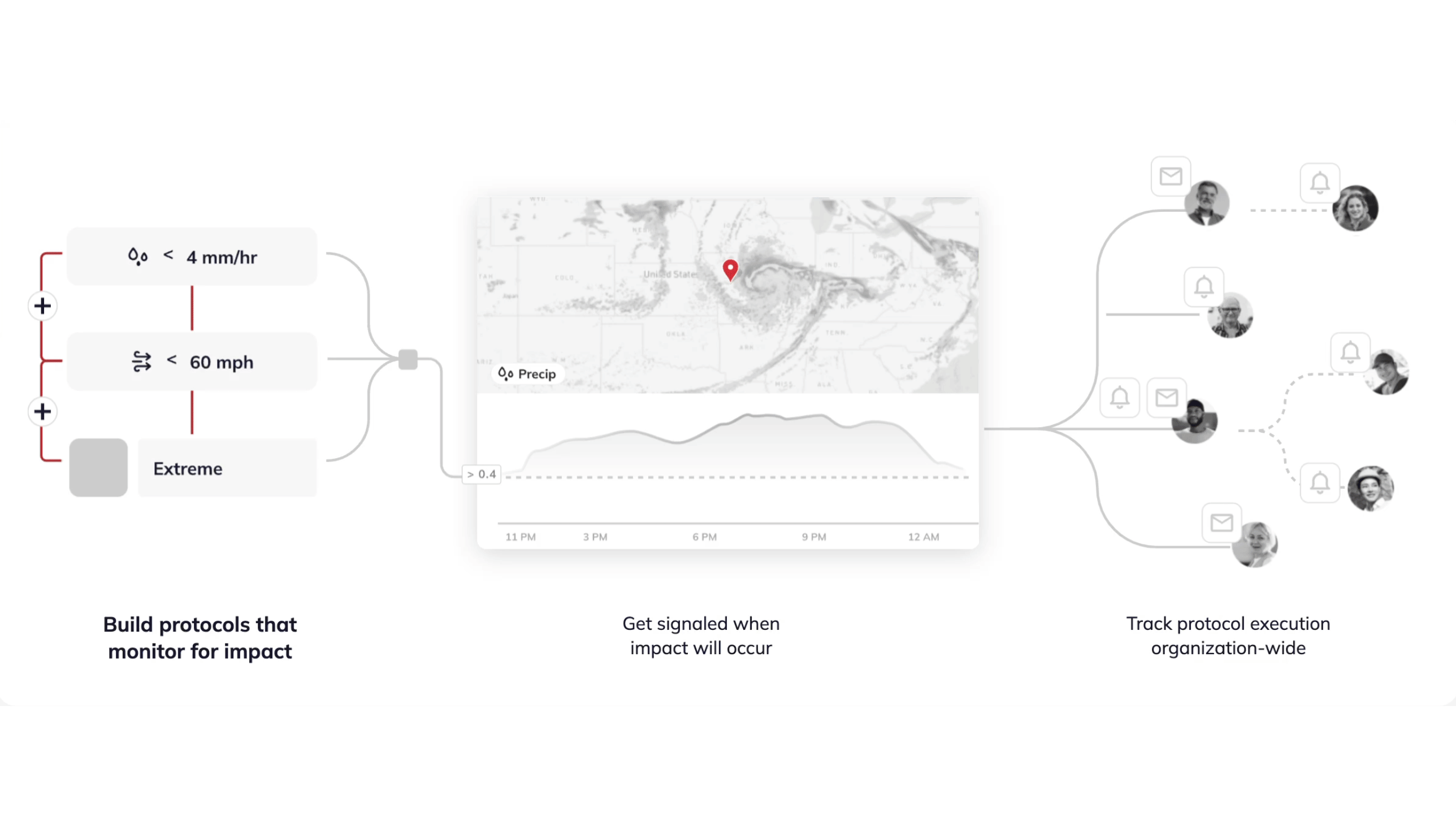TL;DR:
- Weather forecasts combined with innovative tech can enhance business continuity for industry leaders like Uber, Ford, and JetBlue.
- Weather disruptions impact businesses globally, with severe storms, high temperatures, and torrential rains causing significant damage.
- Weather analytics provide valuable insights for predicting disruptions and crafting strategic responses to protect against weather-related losses.
- Businesses can leverage weather data for improved risk assessments, real-time monitoring, and establishing protocols for weather-related emergencies.
- Implementing tools like precision forecasting and automated systems can enhance preparedness and ensure long-term business resilience against weather challenges.
Did you know that weather forecasts can do more than tell you when to carry an umbrella?
When combined with innovative tech, the weather can also be key to maintaining and even enhancing business continuity.
Industry leaders like Uber, Ford, and JetBlue are at the forefront of this business continuity shift as they leverage weather intelligence technology and resilience platforms to inform their operations, mitigate weather risks, and enhance decision-making processes, ultimately improving safety and efficiency across their networks.
Using Weather Data for Enhanced Business Continuity
Consider this – every shift in our planet’s atmosphere has rippling impacts on businesses worldwide.
Atmospheric shifts turn into meteorological shifts, which result in weather disruptions for people, companies, and governments globally.
Severe storms disrupt supply chains, high temperatures lower worker productivity, and torrential rains can cause property damage or loss.
The Role of Weather in Business Operations
Impact of Weather Events on Businesses
High-impact weather events have profound impacts on almost all aspects of business operations.
These natural occurrences cost global economies billions annually, affecting employee safety and productivity levels and jeopardizing logistics and distribution channels.
According to FEMA data, 40-60% of small businesses in the US never reopen after a natural disaster. The US Small Business Administration also found that over 90% of companies fail within two years of being struck by a disaster.
Industries that rely on outdoor activities, such as agriculture, construction, tourism, and utility companies, bear the most significant brunt. But no sector is entirely immune—weather-sensitive elements exist across industries, which means adverse conditions affect profitability universally.
Importance of Weather Analytics in Predicting Disruptions
Thanks to advancing technology, weather analytics can provide valuable data-driven insights that help businesses predict potential risks well in advance, giving them enough time to take effective measures to reduce or avoid those risks.

Weather Intelligence and Resilience Platforms Improve Business Continuity
With advancements like weather intelligence from Tomorrow.io, weather analytics need not be left to meteorologists and climate scientists. Weather data is imperative for informed business decision-making, and new tech makes it easy for anyone to use.
Thus, understanding weather trends and their potential impacts can arm organizations with the foresight to predict likely disruptions, craft strategic responses, and ultimately protect their bottom line against weather-related losses.
Leveraging Weather Data in Business Continuity Planning
Weather data plays a pivotal role in supporting the assessment of potential risks and designing detailed response strategies to overcome weather challenges. Let’s explore how companies can leverage weather data for improved business continuity planning.
Incorporating Weather Forecasts into Risk Assessments
Risk assessment is an integral part of any sound business continuity plan (BCP). By integrating comprehensive weather forecasts, we can significantly strengthen our risk assessment measures.
We’re all well aware of the impact of cold weather on outdoor businesses. Prolonged cold weather and winter storms can cause significant damage to businesses that aren’t well-prepared.
Take winter’s impact on aviation into consideration. Snow directly impacts flights and customer satisfaction, along with ground and flight crew staffing.
Without accurate weather forecasting in place, the industry suffers.
These situations emphasize the importance of having precise and prompt weather forecasts as part of a company’s risk management strategy.
Real-time Monitoring and Alerts for Weather-related Risks
Risk monitoring is as crucial as identification and mitigation when it comes to business operations.
A dynamic ecosystem subject to constant change requires real-time tracking systems that efficiently warn about real impending weather challenges.
Effective communication during severe winter weather is crucial in mitigating disruption caused by internal network disturbances. To address the increasing vulnerability during adverse winter incidents, organizations should consider the following measures:
- Establish defined roles and responsibilities for managing communication during severe weather events
- Implement robust communication methods that can withstand disruptions
- Develop contingency protocols to ensure continuity of operations
- Invest in real-time weather monitoring platforms to stay informed about impending weather threats
- Set up alert systems to notify employees and stakeholders of potential disruptions and safety measures
By implementing these measures, organizations can better prepare for and respond to severe winter weather events, ensuring the continuity of their operations and the safety of their employees.
Robust monitoring resources can keep stakeholders informed about potential disruptions tied to their value chains.
By leveraging technologies like Tomorrow.io’s Gale that applies AI not only in weather modeling but also in predicting climate patterns, businesses can transform hazard alerts into strategic countermeasures, ensuring uninterrupted operations despite challenging weather conditions. Thus reinforcing our belief in using the weather data to enhance business continuity with confidence.
Building a Resilient Response Plan
Weather disruptions substantially impact businesses. Whether it’s in lost revenue, lost time, or mismanaged goods, it is crucial to develop a resilient response plan that can mitigate the prolonged effects of weather-induced disruptions.
Identifying Vulnerabilities to Weather Variability
The first step in building a resilient response plan is identifying your business’s vulnerabilities to weather variability.
Unpredictable weather patterns could expose strategic and operational weaknesses that may have otherwise gone unnoticed. Thoroughly assessing these potential weak spots not only helps pre-emptively address bottlenecks but also provides an opportunity for improvement across multiple facets of your business.
Areas to identify as possible vulnerabilities include:
- Supply chain operations
- Transportation logistics
- Facility infrastructures
- Consumer demand across different seasons
This continuous analysis can work hand-in-hand with leveraging advanced weather data analytics so more targeted strategies are developed.
Establishing Protocols for Weather-related Emergencies
Once vulnerabilities are identified and assessed, establish robust protocols for handling weather-related emergencies. This includes modules on response time, predefined action points depending on varying degrees of disruption severity, as well as clearly delineated roles within the organization during such events.
- Emergency communication channels: Establish clear and reliable emergency communication networks tailored to internal stakeholders (employees) and external ones (customers).
- Duty allocation: Assign responsibilities dynamically or preemptively depending on the expected level of disruption—ensuring every team knows their role vastly improves response times.
- Backup Systems: In cases where primary operations are disrupted severely due to extreme weather elements, backup systems should be sprung into action without delays.
Remember that resilience lies in adaptability. Therefore, constantly updating these proactive measures following real-world testing will ensure ongoing relevance in rapidly evolving climatic conditions.
In the wake of the increasing frequency and intensity of natural catastrophes brought about by climate change phenomena ($2.69 trillion in damages globally over the last 50 years), it becomes even more crucial to have a weather-intelligent approach toward business continuity.
With vulnerabilities addressed and emergencies protocols in place, your enterprise becomes better poised to face impending disruptions while maintaining its operational integrity.
Implementing Tools and Technologies for Enhanced Preparedness
Resilience against weather variability is not only about risk management or forecasting accuracy. It’s also about using smart tools and technologies to enhance preparedness. Deploying the right tools becomes critical when we talk about building business continuity in an era of unpredictable weather patterns.
Two areas are particularly significant in managing environmental risks: applying advanced tools for precision forecasting and implementing automated systems that facilitate rapid response and recovery during a weather event.
Utilizing Scientific Tools for Precision Forecasting
As weather intelligence has become more advanced, businesses can now mitigate their risks with increasingly accurate predictions. Advanced scientific models coupled with cutting-edge technology such as artificial intelligence (AI) can necessarily provide more precise forecasts than ever before.
But how do they accomplish this?
According to Dr. Joe Munchak, Tomorrow.io’s principal atmospheric data scientist, AI is used in its proprietary weather models, which have achieved similar or better performance than traditional methods.
This innovative application of AI enables not just prediction but actual modelling of climate conditions which makes mitigation strategies highly effective. All contributing towards enhanced resiliency against potential disruptions.
Weather AI delivers insights on an unprecedented scale when it comes to predicting and managing the effects of volatile environmental conditions on businesses,. Combining the data analysis power of Weather AI with Tomorrow.io’s satellites ensures granular understanding, boosting accuracy levels in weather prediction, thus increasing preparedness.
Automated Systems for Rapid Response and Recovery
Businesses require agile mechanisms that alert them immediately when a weather risk emerges. Adopting automation is imperative here as it provides immediate alerts on emerging threats, empowering organizations to react swiftly.
Weather technology is giving companies the upper hand in managing weather-related challenges, by improved weather alerting.
Here are just a few examples of how they help:
- Agriculture: Alert farmers of weather in advance to optimize yield and minimize losses by informing decisions around planting, harvesting, and crop protection.
- Transportation: Weather alerts inform early warning systems and ensure safety to adjust routes and schedules during severe weather.
- Energy: With weather alerts, companies can anticipate demand fluctuations, adjust production, and protect infrastructure.
- Construction: Construction companies can use weather alerts to plan projects, schedule work, and ensure worker safety.
Ensuring Long-term Business Resilience Against Weather Challenges
Some studies have shown that the minimum cost per hour of downtime for small businesses amounts to $10,000 – potentially skyrocketing into millions for large corporations. However, implementing sustainable practices and revising business continuity plans periodically can profoundly offset such potential losses.
Developing Sustainable Practices to Mitigate Weather Risks
To mitigate weather risks effectively, businesses need to adopt sustainable practices that transcend beyond mere reactive measures taken post-adversities.
First, invest in resilient infrastructure. Various climatic challenges are paramount – whether it involves constructing flood-proof buildings or installing power backup systems resistant to severe storms.
Second, integrate risk management with ESG and sustainability to hold immense promise towards prolonged operational continuity. For example:
- Reducing Greenhouse Gas (GHG) emissions: Limiting global warming by adopting low-carbon operations can considerably alleviate the increased frequency and severity of extreme weather events.
- Water conservation initiatives: Businesses relying extensively on water resources should implement efficient usage policies or rainwater harvesting systems as insurance against drought spells.
Last, nurture a culture of preparedness among employees. Regular training sessions regarding emergency procedures during hazardous weather can incur minimal interruptions, minimizing the scope for chaos and confusion.
Reviewing and Adapting Business Continuity Plans Periodically
Regular review and adjustment of business continuity plans are essential for handling catastrophes effectively, especially in the face of climate change and its unpredictable impact on weather patterns.
To ensure your plan’s continued relevance and effectiveness:
- Conduct regular revisions to address shortcomings noticed during prior weather events and integrate the latest tools and technologies to enhance prediction accuracy and disaster response plans.
- Monitor scientific advancements by staying informed about the latest developments in climate science and technology, and adapt your plan to incorporate new findings and best practices.
- Reinforce employee awareness by using the review process as an opportunity to update employees on their roles and responsibilities during disasters, strengthening the organizational culture of preparedness.
By instilling sustainable practices, frequently revising continuity procedures, and harnessing the power of technological advancements, businesses can secure smooth operations despite the unpredictable nature of weather events.
Predictive Analytics for Proactive Risk Management
Another noticeable trend making its mark within this realm has been the prominent rise of predictive analytics. Given the volatile nature propelling most climate-related disasters – being proactive rather than reactive when managing risks could undoubtedly tip scales towards our favour.
Predictive analytics utilize artificial intelligence (AI) coupled with advanced statistical methods thereby enabling companies to forecast potential threats much ahead and strategize accordingly. Moreover, these sophisticated systems can learn from past experiences by analyzing successful response actions and incorporating them into future plans thereby eliminating data gaps.
Therefore, it becomes evident that predictive analytics is not just about managing business continuity during an ongoing weather event, but also about investing in a resilient recovery post-event to ensure no stone is left unturned, hence facilitating a cyclic process of constant learning and growth.
This burgeoning dependence on predictive analysis underscores our overall transition towards smart technologies in safeguarding businesses against meteorological disruptions. Enterprises now realize that merely integrating proper weather data isn’t enough — it’s the analytical capabilities that make the real difference. Thus, future trends paint an image of thriving companies becoming increasingly reliant on innovations for integrating weather forecasts with their operations whilst relying on AI-driven analytics to remain proactive against potential threats. This marriage between cutting-edge technology and strategic thinking cements the powerful role of using the weather to enhance business continuity.
Conclusion: Embracing a Weather-intelligent Approach to Business Continuity
The journey of integrating weather intelligence into business continuity planning can be challenging.
However, given the rate at which severe weather occurs (every 18 days, according to NOAA), businesses must consider these scenarios and implement tools to improve resilience and continuity.
Advancements in technology, space, and weather are making it possible for power players like Tomorrow.io to come in and provide a solution for businesses.
Tomorrow.io’s space-based, AI-backed weather forecasts can help you realize the power of weather insights for your organization, protect your enterprise from unpredictable disruptions, and seize untapped opportunities.
















